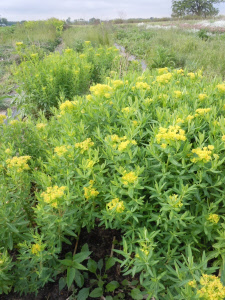Description
OUT OF STOCK
Chartreuse bracts in spring and redish stems and leaves in autumn.
Chartreuse bracts in spring and redish stems and leaves in autumn.
OUT OF STOCK
Chartreuse bracts in spring and redish stems and leaves in autumn.
Golden daisies waive at the sun from July to September, its cup shaped leaves hold water where butterflies drink & bathe
Can not ship to: Connecticut and New York
Size: 7’ x 3’
Care: full sun to part shade in moist soil
Native: Central North America, native to Wisconsin.
Awards: England’s Royal Horticultural Society Award of Merit
Sap used by Native Americans to chew and freshen breath. Also used to cure colds, neuralgia, fever, and liver disorders. The Chippewa used to stop lung hemorrhaging, menstrual bleeding and cure chest pain. The Winnebago drank a potion from the plant to purify themselves before a buffalo hunt. For the Iroquois it cured paralysis, prevented children from seeing ghosts and illness caused by the dead. Lakota Sioux: “Children sometimes use the resin as chewing gum. An infusion of the whole plant is used to rid horses and humans of intestinal worms. An infusion of the leaves is used to loosen phlegm in the lungs. Described and classified in 1753.
OUT OF STOCK
Wine-red petals of bell-shape with yellow centers flowers in early spring. Fun, furry foliage and Medusa-like seed heads.
Size: 12-20” x 4-8”
Care: sun in well-drained to moist well-drained soil
Native: Europe
Wildlife Value: Deer resistant, early pollen source for bees.
Called Pasqueflower because it blooms at Easter time. Variety rubra considered a separate species, not a variety, by Caspar Bauhin in Theatri botanici, 1671. Illustrated in Gerard’s Herball, 1636.
Profusion of small classic daisies May-July atop fragrant silver foliage. Cut back for rebloom. Let the seeds drop for more plants next year. If you cut them back after the 1st flowering they will rebloom for most of the summer and fall.
Size: 2’ x 3’
Care: sun in moist well drained soil
Native: central & southern Europe
Named by Carl Heinrich Schultz (1805-1867)
OUT OF STOCK
Sprays of large, single warming yellow daisies, blushed with apricot top a bushy mound of light green leaves, blooms late-summer to late-fall
Size: 1-2’ x 2-3’ and spreading
Care: Full sun to part shade, tolerates normal, sandy or clay soil
Wildlife Value: Attracts bees, butterflies and birds. Deer resistant.
One of the rubellum hybrids, Hybridized in the 1930’s

